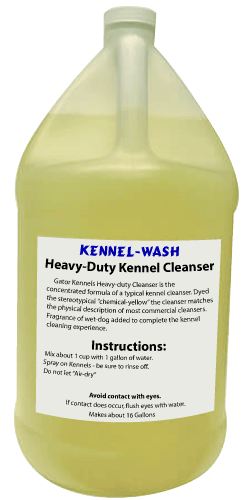Starting Your Own Dog Daycare or Boarding - Cleaning Your Kennels

This is part of a series of blog posts about starting your own dog daycare or boarding business
Click here for the entire series
There are so many different cleansers that can be used to clean the kennels, it would take hours to list them all! We have learned that there are some that work better than others. Some can damage the kennels. And others just cost a lot for very little benefit.
Let's discuss some of the things we look for when picking a cleanser:
- We want a cleanser that cleans - obviously.
- We want a cleanser that is cost-effective. You will be cleaning (a LOT) in a kennel environment, so it would be nice if you didn't go broke buying the cleanser!
- We want a cleanser that is not harmful to the dogs. While you might not be cleaning with the dogs in the kennels, leftover residue can linger behind and could cause discomfort to the dogs. We have seen leftover residue cause mild itching, respiratory irritation, and even 2nd degree chemical burns!
- We want a cleanser that is not harmful to the kennels. While many people overlook this criteria, it can save you thousands of dollars in the long-run! Some cleansers are very corrosive. Most of the time, the metal parts of the kennels will be affected first. Most kennel manufacturers use metals that have a protective coating on the parts - but some cleansers (such as Bleach, Chlorides, Sodium Hydroxide, etc) will remove the protective coating - exposing the metal underneath.
 Some of these criteria are easy to understand and spot. The price-tag for example lets you know how much the cleanser costs. However, keep in mind that many cleansers are sold in concentrated form. After you mix it with water, you will end up with a LOT more cleanser than what it first appears! Check the mixing instructions to determine how much cleanser the concentrate will make.
Some of these criteria are easy to understand and spot. The price-tag for example lets you know how much the cleanser costs. However, keep in mind that many cleansers are sold in concentrated form. After you mix it with water, you will end up with a LOT more cleanser than what it first appears! Check the mixing instructions to determine how much cleanser the concentrate will make.
The other criteria is harder to spot. The first place to look is the back label of the product. The manufacturer is required to list any potential health hazards. Keep in mind that not ALL health-hazards are listed on the label - just the biggest ones are listed. For a complete list, you will need the MSDS (Material Safety Data Sheet). Most MSDS can be found online. It is probably worth your time to download and print this sheet as many states REQUIRE you to have the MSDS paperwork on-file! It is also good to include the 'safe handling instructions' to your employee training as your employees need to know how to mix and use the cleanser. Including this information to the training will not only avoid potential safety issues, it can also help you save money! It is amazing how many facilities we've visited that did not include the mixing instructions to the employee training and the employees are using the cleanser without diluting it (in concentrate form) and even spraying the product near or on the dogs!
In addition to helping you determine the health-hazards, the MSDS will give you clues if the product will harm the kennels. Look to see if the product will attack the materials your kennels are made from: wood, plastics, metals. Sometimes it can be hard to tell, so look for keywords such as: Reactivity, Oxidation, Acids, and chemical names that include: Chlorides, Bromides.
So... What do you recommend as cleansers to clean the kennels?
We have found a few products that work really well - and meet the criteria discussed earlier.
- Scrubbing Bubbles® multi-surface bathroom cleaner.
- Dawn® Dish Soap.
- Simple Green Dog Bio-boost Stain & Odor Remover.
- ThymoCide Disinfectant.
Wait - why aren't any "professional" kennel cleansers listed?
While there are many professional kennel cleansers that also meet the criteria listed above, we have found most are so focused on disinfecting (killing Parvo, etc) that most will damage the kennels. Additionally, most require extra steps to use properly and are not available in every State - making it hard to recommend to all of our customers.
Other Notes:
- Nearly every disinfectant REQUIRES you to rinse the product off the surfaces!! Be sure to read the instructions fully!
- Disinfectants that claim to also include viable bacteria cultures is simply a marketing scheme. By definition, the disinfectant should kill ALL bacteria - it cannot discriminate between the 'good' or 'bad' bacteria. Therefore, the bacteria culture should not survive being bottled with the disinfectant. Don't bother wasting money buying the hype!
- Most dogs will show the following symptoms when exposed to chemical disinfectants:
- Skin irritation. Dogs will scratch/itch - sometimes to the point of drawing blood!
- Hair falling out. Dogs might scratch off the hair - or in severe cases, it might have burned off!
- Respiratory symptoms. Sneezing, coughing, rasping. This is commonly misdiagnosed as kennel-cough!
- Digestive Symptoms. Vomiting, Diarrhea, Tongue/Throat rashes.
As you can see, many symptoms of chemical exposure look like other common kennel problems. Most of the time these are misdiagnosed and the temptation is for the kennel facility to apply more chemicals! This situation can be avoided if you mix the product properly, follow the instructions properly, rinse the product off the surfaces, and keep the dogs from playing/drinking any puddles that might contain the cleanser. The proper use of a cleanser that meets the above criteria will save you money, protect your investment, and keep the dogs safe!
